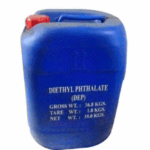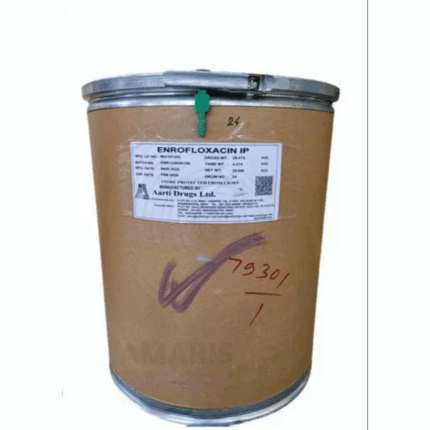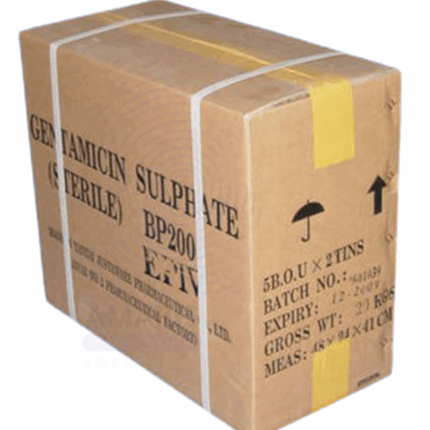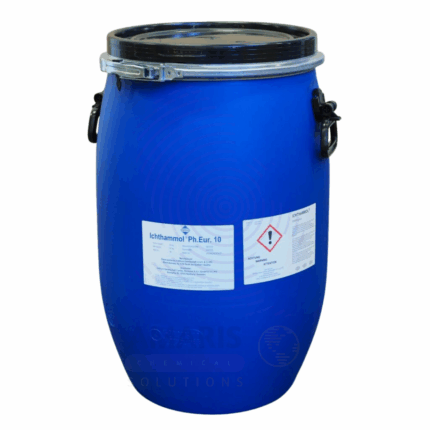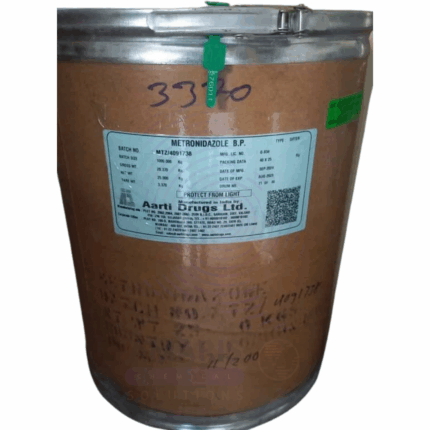Diloxanide Furoate
Diloxanide Furoate is an orally administered antiprotozoal agent used primarily for the treatment of amoebiasis. It is a furan-based derivative that acts as a luminal amoebicide, effectively targeting Entamoeba histolytica cysts and trophozoites within the intestinal lumen. This compound is well-regarded for its efficacy in eradicating asymptomatic cyst carriers and as a follow-up treatment after systemic amoebicidal therapy. Diloxanide Furoate has good oral bioavailability and a favorable safety profile.
Diloxanide Furoate Uses
Primary Uses
- Pharmaceutical Use – Anti-amoebic Agent
- Used to treat asymptomatic and mild-to-moderate intestinal amoebiasis caused by Entamoeba histolytica.
- Acts specifically on the luminal stage of the parasite, clearing cysts from the intestinal tract to prevent transmission and relapse.
- Commonly administered following systemic amoebicides like metronidazole to ensure complete eradication of infection.
- Parasitic Infection Control
- Employed in mass treatment campaigns in endemic regions to reduce amoebiasis prevalence.
- Utilized for prophylactic purposes in travelers to endemic areas as a preventive therapy against amoebic infections.
- Combination Therapy
- Often used in combination with other anti-amoebic drugs for synergistic effects, improving cure rates and minimizing drug resistance.
Secondary Uses
- Research Applications
- Used as a reference compound in parasitology and pharmacology research to study anti-amoebic mechanisms and drug resistance.
- Veterinary Use (Limited)
- Occasionally applied off-label in veterinary medicine for protozoal infections in animals, though human pharmaceutical grade predominates.
1. Basic Identification Attributes
- Chemical Name (IUPAC): 2-(Dichloromethylidene)aminooxy-N-(furan-2-ylmethyl)acetamide
- Common/Trade Name: Diloxanide Furoate
- CAS Number: 135-91-3
- HS Code: 2941.30.00
- Molecular Formula: C10H8Cl2N2O4
- Synonyms:
- Diloxanide Furoate
- Diloxanide
- 2,2-Dichloro-N-[(furan-2-yl)methyl]acetamide
2. Physical & Chemical Properties
- Physical State: Off-white to pale yellow crystalline powder
- Odor: Odorless to slight characteristic odor
- Melting Point: Approximately 150–154°C
- Solubility: Slightly soluble in water; soluble in organic solvents like methanol and ethanol
- Stability: Stable under recommended storage conditions; sensitive to moisture
3. Safety & Hazard Attributes
- Hazard Class (GHS): Not classified as hazardous but handle with care
- Toxicity: Low acute toxicity; avoid ingestion in non-therapeutic doses
- Exposure Limits: No specific occupational limits; standard precautions apply
4. Storage & Handling Attributes
- Storage Conditions: Store in a cool, dry place away from direct sunlight and moisture
- Container Type: Sealed airtight containers or pharmaceutical-grade packaging
- Shelf Life: Typically 2–3 years if stored properly
- Handling Precautions: Use gloves and avoid dust inhalation during handling
5. Regulatory & Compliance Attributes
- Approved by major pharmacopeias (e.g., USP, BP) for pharmaceutical use
- Included in WHO Essential Medicines List for Amoebiasis
- Registered under regulatory bodies for human medicinal use
6. Environmental & Health Impact
- Ecotoxicity: Low; minimal environmental persistence in normal disposal conditions
- Biodegradability: Expected to degrade under aerobic environmental conditions
- Bioaccumulation: Not expected
Safety Handling Precautions
PPE Required:
- Gloves (nitrile or latex)
- Safety goggles
- Lab coat or protective apron
- Dust mask if powder handling generates dust
Handling Guidelines:
- Avoid inhalation of dust and skin contact
- Use in well-ventilated areas or under fume extraction
- Prevent contamination of food, feed, and water sources
Storage Masures:
- Keep container tightly closed and store in a dry environment
- Protect from moisture and heat
- Segregate from incompatible substances
Hygiene Practices:
- Wash hands thoroughly after handling
- Do not eat, drink, or smoke while handling product
- Use clean tools and avoid cross-contamination
First Aid Measures
- Inhalation: Move to fresh air; if respiratory irritation occurs, seek medical attention
- Skin Contact: Wash affected area with soap and water; seek medical advice if irritation persists
- Eye Contact: Rinse immediately with plenty of water for at least 15 minutes; consult physician if irritation develops
- Ingestion: Rinse mouth; do not induce vomiting unless directed by a physician; seek medical care immediately
Firefighting Measures
- Fire Hazards: Not highly flammable; may decompose on heating emitting toxic fumes
- Extinguishing Media: Use water spray, foam, dry chemical, or CO₂ extinguishers
- Special Precautions: Firefighters should wear protective equipment and respiratory protection
- Decomposition Products: May emit hydrogen chloride and other toxic gases upon combustion
Related products
Enrofloxacin Hydrochloride
Gentamycin Sulphate
Hydrocortisone Base BP 93 Micro
Ichthammol BP98
Lidocaine HCL BP
Mebendazole USP
Metronidazole BP
Miconazole Nitrate BP
Miconazole Nitrate BP is a high-purity, pharmaceutical-grade antifungal agent conforming to British Pharmacopoeia (BP) specifications. It is widely used in the formulation of topical and oral pharmaceutical products for the treatment of fungal infections caused by dermatophytes and yeasts, including Candida species. Miconazole Nitrate functions by inhibiting the biosynthesis of ergosterol, a vital component of fungal cell membranes, leading to cell death.
This white to off-white crystalline powder is highly effective and exhibits broad-spectrum antifungal and some antibacterial activity. It is commonly utilized in creams, ointments, powders, and gel formulations.


 Preservatives(food)
Preservatives(food) Flavor Enhancers
Flavor Enhancers Acidulants
Acidulants Sweeteners
Sweeteners Antioxidants
Antioxidants Colorants(food)
Colorants(food) Nutraceutical Ingredients (food)
Nutraceutical Ingredients (food) Nutrient Supplements
Nutrient Supplements Emulsifiers
Emulsifiers
 Collectors
Collectors Dust Suppressants
Dust Suppressants Explosives and Blasting Agents
Explosives and Blasting Agents Flocculants and Coagulants
Flocculants and Coagulants Frothers
Frothers Leaching Agents
Leaching Agents pH Modifiers
pH Modifiers Precious Metal Extraction Agents
Precious Metal Extraction Agents
 Antioxidants(plastic)
Antioxidants(plastic) Colorants (Pigments, Dyes)
Colorants (Pigments, Dyes) Fillers and Reinforcements
Fillers and Reinforcements Flame Retardants
Flame Retardants Monomers
Monomers Plasticizers
Plasticizers Polymerization Initiators
Polymerization Initiators Stabilizers (UV, Heat)
Stabilizers (UV, Heat)
 Antifoaming Agents
Antifoaming Agents Chelating Agents
Chelating Agents Coagulants and Flocculants
Coagulants and Flocculants Corrosion Inhibitors
Corrosion Inhibitors Disinfectants and Biocides
Disinfectants and Biocides Oxidizing Agents
Oxidizing Agents pH Adjusters
pH Adjusters Scale Inhibitors( water)
Scale Inhibitors( water)
 Antioxidants(cosmetic)
Antioxidants(cosmetic) Emollients
Emollients Fragrances and Essential Oils
Fragrances and Essential Oils Humectants
Humectants Preservatives
Preservatives Surfactants(cosmetic)
Surfactants(cosmetic) Thickeners
Thickeners UV Filters
UV Filters
 Fertilizers
Fertilizers Soil Conditioners
Soil Conditioners Plant Growth Regulators
Plant Growth Regulators Animal Feed Additives
Animal Feed Additives Biostimulants
Biostimulants Pesticides (Herbicides, Insecticides, Fungicides)
Pesticides (Herbicides, Insecticides, Fungicides)
 Active Pharmaceutical Ingredients (APIs)
Active Pharmaceutical Ingredients (APIs) Excipients
Excipients Solvents(pharmaceutical)
Solvents(pharmaceutical) Antibiotics
Antibiotics Antiseptics and Disinfectants
Antiseptics and Disinfectants Vaccine Adjuvants
Vaccine Adjuvants Nutraceutical Ingredients (pharmaceutical)
Nutraceutical Ingredients (pharmaceutical) Analgesics & Antipyretics
Analgesics & Antipyretics
 Analytical Reagents
Analytical Reagents Solvents(lab)
Solvents(lab) Chromatography Chemicals
Chromatography Chemicals Spectroscopy Reagents
Spectroscopy Reagents microbiology-and-cell-culture-reagents
microbiology-and-cell-culture-reagents Molecular Biology Reagents
Molecular Biology Reagents Biochemical Reagents
Biochemical Reagents Inorganic and Organic Standards
Inorganic and Organic Standards Laboratory Safety Chemicals
Laboratory Safety Chemicals Specialty Laboratory Chemicals(Special Laboratory Equipment)
Specialty Laboratory Chemicals(Special Laboratory Equipment)
 Demulsifiers
Demulsifiers Hydraulic Fracturing Fluids
Hydraulic Fracturing Fluids Scale Inhibitors(oil)
Scale Inhibitors(oil) Surfactants(oil)
Surfactants(oil) Drilling Fluids
Drilling Fluids
 Dyes and Pigments
Dyes and Pigments Bleaching Agents
Bleaching Agents Softening Agents
Softening Agents Finishing Agents
Finishing Agents Antistatic Agents
Antistatic Agents
 Admixtures
Admixtures Waterproofing Agents
Waterproofing Agents Sealants and Adhesives
Sealants and Adhesives Curing Compounds
Curing Compounds Concrete Repair Chemicals
Concrete Repair Chemicals Anti-Corrosion Coatings
Anti-Corrosion Coatings
 Surfactants(cleaning)
Surfactants(cleaning) Builders
Builders Enzymes
Enzymes Solvents (Cleaning)
Solvents (Cleaning) Fragrances
Fragrances
 Electronic Chemicals
Electronic Chemicals Catalysts
Catalysts Lubricants
Lubricants Photographic Chemicals
Photographic Chemicals Refrigerants
Refrigerants Automotive chemicals
Automotive chemicals Pyrotechnic Chemicals
Pyrotechnic Chemicals
 Biodegradable Surfactants
Biodegradable Surfactants Bio-based Solvents
Bio-based Solvents Renewable Polymers
Renewable Polymers Carbon Capture Chemicals
Carbon Capture Chemicals Wastewater Treatment Chemicals
Wastewater Treatment Chemicals
 Pigments
Pigments Solvents(paint)
Solvents(paint) Specialty Coatings
Specialty Coatings Binders/Resins
Binders/Resins Additives
Additives Driers
Driers Anti-Corrosion Agents
Anti-Corrosion Agents Functional Coatings
Functional Coatings Application-Specific Coatings
Application-Specific Coatings
 Fresh Herbs
Fresh Herbs Ground Spices
Ground Spices Whole Spices
Whole Spices Spice Blends
Spice Blends Dried Herbs
Dried Herbs
 Leavening Agents
Leavening Agents Dough Conditioners
Dough Conditioners Flour Treatments
Flour Treatments Fat Replacers
Fat Replacers Decoratives
Decoratives Preservatives(baking)
Preservatives(baking)
 Plasticizers & Softeners
Plasticizers & Softeners Reinforcing Agents
Reinforcing Agents Adhesion Promoters
Adhesion Promoters Vulcanizing Agents
Vulcanizing Agents Antidegradants
Antidegradants Blowing Agents
Blowing Agents Fillers & Extenders
Fillers & Extenders Accelerators & Retarders
Accelerators & Retarders
